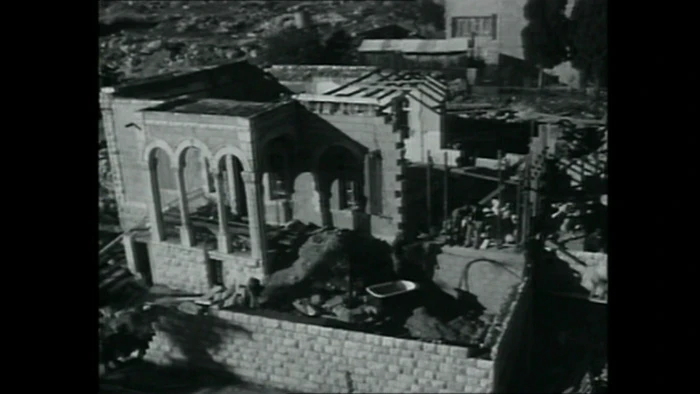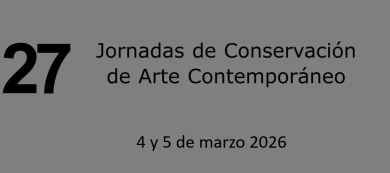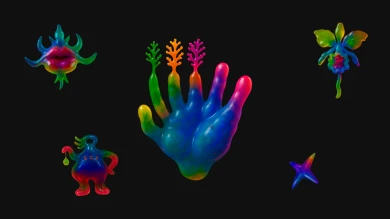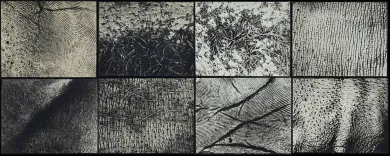-
5 February, 2014 Sabatini Building, Auditorium
Colloquium. Amos Gitai, in conversation with Jean-François Chevrier
This event serves as an introduction to both the film series and the exhibition dedicated to the filmmaker. With a notion of documentary as a poetic tale of resistance, the work of Amos Gitai has profound links with the narration of place using life experience, an aspect that lends structure to the exhibitions Biographical Forms and The Biographies of Amos Gitai, both curated by Jean-François Chevrier.
-
6 February, 2014 Sabatini Building, Auditorium
Session 1. Architecture and House
House
1980, hard drive, original version with Spanish subtitles, 51’Architecture
1978, hard drive, original version with Spanish subtitles, 13’15House, or Baït according to the common transcription of the Arabic and Hebrew words, is the story of a house in West Jerusalem. The home belonged to a Palestinian family until the war in 1948 that, with the founding of the state of Israel, forced its owners into exile. At the time of the filming, the house is in the process of being enlarged. The film features the voices of the successive owners and renters (from 1956 onwards) and also that of the previous owner, Mahmud Dajani, a Palestinian doctor who must live with the errors of the radicalism of his defeated compatriots. Some neighbours recount their memories. A Palestinian worker denounces his working conditions and Israeli domination of the occupied territories.
Two years earlier Gitai had directed what he himself called his last film on architecture, Architecture, which was shot in Haifa. The International Style, which his father the architect Munio Weinraub Gitai (1907-1970) followed, is denounced by means of a comparison with vernacular forms of construction.
-
11 February, 2014 Sabatini Building, Auditorium
Session 2. Field Diary
Field Diary
1982, blu-ray, original version with Spanish subtitles, 83’This film examines the legitimisation of the violence used against the Palestinians: It is the story of the occupier’s inability to face up to his own actions, taking refuge in abstractions (God, the Nation, Security) and turning that into a mechanism for legitimising what he does , in the words of Gitai. The filming began three months before the Israeli invasion of Lebanon. The film describes the escalation of violence and how it becomes installed in people’s mentalities. The takes are long and the film is made up of sequences that are dramatic units in themselves. Various sequences are devoted to a visit with the mayor of Nablus, who is under home arrest. The dramatic argument resides in the confrontation between the witness-filmmaker (the small crew behind the camera) and the police forces (the army) and the revelation of the effects that nationalist propaganda has on young Israeli soldiers.
-
12 February, 2014 Sabatini Building, Auditorium
Session 3. Pineapple
Pineapple
1983, blu-ray, original version with Spanish subtitles, 78’This film is an inquiry into the methods of rationalisation and exploitation used by multinationals in today's global economy. The example studied is a pineapple-producing company with headquarters in Honolulu , a distribution subsidiary in San Francisco , and croplands in Hawaii , although cultivation is in the process of being outsourced to the Philippines . The voices are those of the people involved in this system: upper and middle level management, foremen and workers, in the fields and in the packaging facilities. Part of the “packaging” is also the Christian moral propaganda that allows order to be maintained without physical violence.
-
13 February, 2014 Sabatini Building, Auditorium
Session 4. Bangkok-Bahrain. Labour for sale
Bangkok-Bahrain. Labour for sale
1984, blu-ray, original version with Spanish subtitles, 78’
Shot one year after Pineapple, this documentary is an uncomfortable look at the extreme forms of modern slavery existing in Thailand: prostitution and the trade in labourers hired for jobs in the Persian Gulf. The film gives a voice to the people who benefit from this exploitation. It also attempts to overcome the silence imposed on both prostitutes and emigrant workers. Enslaved bodies are given words under coercion. The film points out the obstacles to these people telling their story, a minimum condition of identity and a means towards emancipation.
-
17 February, 2014 Sabatini Building, Auditorium
Session 5. Esther
Esther
1985, 35mm, original version with Spanish subtitles, 97' Courtesy of the Institut FrançaisEsther is Gitai’s first fiction film. Conceived as an immense tableau vivant , it tells the Old Testament story of Esther. The film was shot in the ruins of Haifa ’s old Arab quarter, Wadi Salib, where Palestinians lived until 1948. The neighbourhood was destroyed in 1959 as a result of a rebellion by the newly-arrived Sephardic population against the power monopoly held by the Ashkenazi community. This historical stratification becomes the setting for the biblical tale, which tells of the struggle by the Hebrew people to survive in the Persian Empire . In the end violence is exercised also by those who have been oppressed. But the film concludes with a return to the present: each of the main actors tells his or her own story.
-
18 February, 2014 Sabatini Building, Auditorium
Session 6. A House in Jerusalem
A House in Jerusalem
1998, blu-ray, original version with Spanish subtitles, 85’Eighteen years after his first feature film, Gitai returned to the locations of House and resumed his investigation: the time of a generation has passed, Mahmud Dajani is now dead, his son has adopted Canadian nationality and his granddaughter says she is moving to Canada. The film’s territory has become larger, it is now about several houses instead of just one. An Englishman and a Swedish woman have moved into the neighbourhood. Palestinian workers , Gitai comments, discover Jewish archaeological sites that will later be used to justify the expulsion of the Palestinians.
-
19 February, 2014 Sabatini Building, Auditorium
Session 7. Kippur
Kippur
2000, 35mm, original version with Spanish subtitles, 120' Courtesy of the Institut FrançaisOn October 11th, 1973, during the Yom Kippur war, the helicopter Gitai was aboard was shot down by a missile. The film reconstructs the episode and the circumstances surrounding it, beginning with the declaration of war. Kippur is one of the best examples of the war film genre in recent filmmaking. The war is shown to be a present time inscribed in people’s gestures, a present that takes over bodies and impregnates biographies. The images have a great physical presence; the sound is imposing, horrific. I tried to create an ongoing bombardment of sound. I wanted people to feel that the episode is beyond the camera’s control, that it exceeds our field of vision , states Gitai.
-
24 February, 2014 Sabatini Building, Auditorium
Session 8. News from Home/News from House
News from Home/News from House
2005. 35mm, original version with Spanish subtitles, 97’ Courtesy of the Institut FrançaisAt the beginning of this film, a sign says: This film, House , has been filmed three times over the past twenty-five years. This tends to make one think that the three films devoted to this house in Jerusalem are but one. Gitai suggests as well that the cinematographic story absorbs the time period. The film is shown to be akin to a construction taking place over time and history. In the words of the filmmaker: In a way, documentaries are something like a human archaeological site, I think this is the function of documentaries in general: to excavate, to make the plan as a whole appear, to reveal the structure masked by the present (…). Layer by layer we see the characters arriving: workers, owners, people bringing little things, fragments of memories, events, photographs.
-
26 February, 2014 Sabatini Building, Auditorium
Session 9. Carmel
Carmel <
2009, hard drive, original version with Spanish subtitles, 93’Carmel is one of the two films that Gitai has dedicated recently to his parents. The main character is Efratia Margalit Gitai. She passed away in 2004, having been born in 1909 in Palestine, (Haifa) to parents recently emigrated from central Europe. She married the architect Munio Weinraub Gitai in 1936. The film, conceived as a poetic montage of documents and acted sequences, reconstructs the key moments in Efratia’s life, but also in the life of Amos, as a child and then as an adult, in relation with his own children. The documentary material comprises essentially family photos and letters read by actors, with the addition of a fragment of film-memory shot in super 8. The archaeological form of House is found here as an elegy. Carmel is the name of the mountain looming over Haifa.

Held on 05, 06, 11, 12, 13, 17, 18, 19, 24, 26 Feb 2014
This series spans more than thirty years of activity by Amos Gitai, beginning with Architecture, a short film from 1978. This film, made when the filmmaker still planned to pursue a career in architecture, already contained signs of the critical dimension that would be confirmed in his later documentaries. Gitai became a filmmaker when he made House in 1980. With its return visits and continuations in 1998 (A House in Jerusalem) and 2005 (News from Home/News from House), this film can be likened to a coming-of-age novel of an architect-filmmaker. It tells the story of a dispossession, from the vantage point of the house’s former owner, a Palestinian forced to leave in 1948. The current circumstances of the Israeli-Palestinian conflict are seen in the builders’ living and working conditions in 1980.
For Gitai, the present is inscribed in a time period and also in a historical stratum. The blending of these two approaches, which constitutes the principal strength of his documentary films, is also seen in his fiction works, such as Esther (1985), Kippur (2000) and Carmel (2009). Long sequence shots, which express a kind of continuity, are inserted into a montage of fragmentary and at times dissonant shots. The story, with its biographical or autobiographical content, encompasses and overcomes the documentary/fiction distinction upon which cinematic discourse still rests and which Gitai takes apart.
House illustrates that the dramatic processes of documentary film are analogous to the constructive methods of an architect. The construction of the film responds to the transformation of the house. The quarry from which the Palestinian workers extract the stone is an allegorical place. The power relations characteristic of the world of labour are related to a situation of political domination, based on the appropriation of territory.
Produced in Israel by a television network, the film has never been distributed in that country. But Field Diary, shot in March of 1982, just before the war with Lebanon, did lead to a climate of hate, as Gitai described it, that prompted him to take exile in France. Pineapple and Bangkok-Bahrain were made from this position of distance. The two films use investigative reporting practices and constitute a diptych on the networks of exploitation and servitude at the international level.
The central question explored by Gitai’s work, and found throughout the nine features and the short film that make up this series, is the construction/violence relation, particularly vivid for an architect-filmmaker in a country in which territorial conflicts are always accompanied by acts of construction and destruction. Constructions appear as the response to or the prolongation of violence. Like violence, construction is material, physical yet it also has a symbolic dimension. That is why his films are an ensemble of elements that take on meaning in the course of a story, inside a film or from one film to another. Gitai is an architect-filmmaker, but he is also a biographer-filmmaker. His life is one of the biographies that make up an open-ended opus, an opus under construction.
Más actividades

Difficulty. Forms and Political Effects of Deviation in Writing and Contemporary Art
23 February – 14 December 2026 – Check programme
Difficulty. Forms and Political Effects of Deviation in Writing and Contemporary Art is a study group aligned towards thinking about how certain contemporary artistic and cultural practices resist the referentiality that dominates the logics of production and the consumption of present-day art. At the centre of this proposal are the concepts of difficulty and deviation, under which it brings together any procedure capable of preventing artistic forms from being absorbed by a meaning that appears previous to and independent from its expression. By ensuring the perceptibility of their languages, difficulty invites us to think of meaning as the effect of a signifying tension; that is, as a productive and creative activity which, from the materiality of art objects, frees aesthetic experience from the representational mandate and those who participate in it from the passiveness associated with tasks of mimesis and decoding.
The economy of the referential norm translates the social logic of capitalism, where insidious forms of capturing subjectivity and meaning operate. In the early 1980s, and adopting a Marxist framework, poet Ron Silliman highlighted how this logic entailed separating language from any mark, gesture, script, form or syntax that might link it to the conditions of its production, rendering it fetichised (as if without a subject) and alienating its users in a use for which they are not responsible. This double dispossession encodes the political strategy of referential objectivity: with no subject and no trace of its own consistency, language is merely an object, that reality in which it disappears.
The political uses of referentiality, more sophisticated today than ever before, sustain the neoliberal-extractivist phase of capitalism that crosses through present-day societies politically, economically and aesthetically. Against them, fugitive artistic practices emerge which, drawing from Black and Queer studies and other subaltern critical positions, reject the objective limits of what exists, invent forms to name what lies outside what has already been named, and return to subjects the capacity to participate in processes of emission and interpretation.
Read from the standpoint of artistic work, the objective capture of referentiality may be called transparency. Viewed from a social contract that reproduces inequality in fixed identity positions, transparent in this objectivity are, precisely, the discourses that maintain the status quo of domination. Opposite the inferno of these discourses, this group aims to collectively explore, through deviant or fugitive works, the paradise of language that Monique Wittig encountered in the estranged practices of literature. For the political potency of difficulty — that is, its contribution to the utopia of a free language among equals — depends on making visible, first, its own deviations; from there, the norm that those deviations transgress; and finally, the narrowness of a norm which in no way exhausts the possibilities ofsaying, signifying, referring and producing a world.
From this denouncement of referential alienation, fetishisation and capture, Difficulty. Forms and Political Effects of Deviation in Writing and Contemporary Art turns its attention to the strategies of resistance deployed by contemporary artists and poets. Its interest is directed towards proposals as evidently difficult or evasive as those of Gertrude Stein, Lyn Hejinian, Theresa Hak Kyung Cha, Kameelah Janan Rasheed, Kathy Acker, María Salgado and Ricardo Carreira, and as seemingly simple as those of Fernanda Laguna, Felix Gonzalez Torres and Cecilia Vicuña, among other examples that can be added according to the desires and dynamics of the group.
The ten study group sessions, held between February and December, combine theoretical seminars, work with artworks from the Museo Reina Sofía’s Collections and exhibitions, reading workshops and public programs. All these formats serve as spaces of encounter to think commonly about certain problems of poetics — that is, certain political questions — of contemporary writing and art.
Difficulty. Forms and Political Effects of Deviation in Writing and Contemporary Art inaugurates the research line Goodbye, Representation, through which the Museo Reina Sofía’s Studies Directorship seeks to explore the emergence of contemporary artistic and cultural practices which move away from representation as a dominant aesthetic-political strategy and redirect their attention toward artistic languages that question the tendency to point, name and fix, advocating instead for fugitive aesthetics. Over its three-year duration, this research line materializes in study groups, seminars, screenings and other forms of public programming.

CLINIC 2628. A Community of Writing and Research in the Arts
February – October 2026
Clinic 2628 is a project which supports and brings together writings which stem from the intention to offer a space and sustainable time for research work in art and culture. Framed within an academic context which is increasingly less receptive to the forms in which thinking happens and is expressed, the aim is to rescue the academic from its neoliberal trappings and thus recover the alliance between precision and intuition, work and desire. A further goal is to return writing to a commons which makes this possible through the monitoring of processes and the collectivisation of ideas, stances, references and strategies.
The endeavour, rooted in a collaboration between the Museo Reina Sofía’s Studies Directorship and the Artea research group, via the i+D Experimenta project, is shaped by three annual editions conceived as spaces of experimentation, discussion and a demonstration of writings critical of what is put forward by today’s academia.
What forces, forms and processes are at play when writing about art and aesthetics? In academia, in museums and in other cultural institutions, the practice of writing is traversed by productivist logics which jeopardise rhythms of research and experimentation. The imposition of both scientism inherent in the structure of “the paper” and the quantifying of results which demand a criterion of quality and visibility sterilise and smoothen, from the outset, the coarseness that is particular to writing understood from the concrete part of language: phonic, graphic, syntactic and grammatical resistance connecting the language user to the community the language unites and activates. They also sterilise the roughness enmeshed in the same desire to write, the intuitive, clear and confusing pathways that once again connect the writer to those reading and writing, participating in a common good that is at once discovered and produced.
The progressive commercialisation of knowledge propelled by cognitive capitalism moves further away from the research and production of knowledge in artworks and artistic languages and practices. The work of curators and archive, criticism, performances and essays formerly saw a horizon of formal and emotional possibilities, of imagination that was much broader when not developed in circumstances of competition, indexing and impact. Today, would it be possible to regain, critically not nostalgically, these ways; namely, recovering by forms, and by written forms, the proximity between art thinking and its objects? How to write in another way, to another rhythm, with no more demands than those with which an artwork moves towards different ways of seeing, reading and being in the world?

27th Contemporary Art Conservation Conference
Wednesday, 4, and Thursday, 5 March 2026
The 27th Contemporary Art Conservation Conference, organised by the Museo Reina Sofía’s Department of Conservation and Restoration, with the sponsorship of the MAPFRE Foundation, is held on 4 and 5 March 2026. This international encounter sets out to share and debate experience and research, open new channels of study and reflect on conservation and the professional practice of restorers.
This edition will be held with in-person and online attendance formats, occurring simultaneously, via twenty-minute interventions followed by a five-minute Q&A.
Submitting Proposals
The deadline for presenting proposals ends on 28 September 2025. Those interested must send an email to jornada.conservacion@museoreinasofia.es, submitting the following documents:
- An unpublished proposal related to the conservation or restoration of contemporary art.
- A 1,700-word summary, written in Word, on the theme addressed. Please indicate the topic at the top of the document with five keywords and the presentation format (in-person or virtual). Preference will be given to the in-person format.
- CV and contact details.
- Only one proposal per person will be accepted.
- Proposals related to talks given in the last three conferences will not be accepted.
Proposals may be submitted in Spanish, French or English and will be evaluated by a Scientific Committee, which will select the submissions to be presented during these conference days and will determine their possible participation in a subsequent publication, the inclusion of which will undergo a second and definitive evaluation by the Editorial Committee.
For submissions in a virtual format, participants must send a recording following certain technical requirements they will receive once participation is confirmed.
The programme of sessions will be published in the coming days.

Cultural Work
Thursday, 12 February 2026 – 5:30pm
This series is organised by equipoMotor, a group of teenagers, young people and older people who have participated in the Museo Reina Sofía’s previous community education projects, and is structured around four themed blocks that pivot on the monstrous.
Session number two looks to approach film as a place from which cultural work is made visible and processes of production engage in dialogue with artistic creation. From this premise, the session focuses on exploring how audiovisual content is produced, assembled and distributed, from the hands that handle the images to the bodies that participate in its circulation. The aim is to reflect on the invisible effort, precarity and forms of collaboration that uphold cultural life, that transform the filmic experience into an act that recognises and cares for common work.

The (legal) person and the legal form. Chapter II
8, 12, 15 January, 2026 – 16:00 to 19:00
As part of the Studies Constellation, the Study Directoship’s annual fellowship, art historian and theorist Sven Lütticken leads the seminar The (Legal) Person and the Legal Form: Theoretical, Artistic, and Activist Commitments to foster dialogue and deepen the hypotheses and questions driving his research project.
This project, titled Unacting Personhood, Deforming Legal Abstraction, explores the dominance of real abstractions—such as exchange value and legal form—over our processes of subjectivation, and asks how artistic practices can open up alternative ways of representing or performing the subject and their legal condition in the contemporary world.
The seminar consists of eight sessions, divided into three chapters throughout the academic year. While conceived as non-public spaces for discussion and collective work, these sessions complement, nourish, and amplify the public program of the Studies Constellation.
In this second chapter of the seminar, the inquiry into the aesthetics and politics of legal form continues with three sessions that pick up the discussions held in Chapter I but propose new lines of flight. The first session focuses on international law via the writings of the British author China Miéville, which allows us to reconsider the notion of the legal form –following Evgeny Pashukanis— and, through it, a variety of (people’s) tribunals. While the crucial concept of the legal person –as the right-holder central to the form of law— was debated in Chapter I, the second session focuses on attempts to extend personhood not (just) to corporations, but rather to nonhuman animals or ecosystems. Finally, the third session poses the question: how can groups and networks use officially recognized organizational forms (such as the foundation or the cooperative) and/or use a collective persona (without necessarily a legal “infrastructure” to match) to act and represent themselves?





![Miguel Brieva, ilustración de la novela infantil Manuela y los Cakirukos (Reservoir Books, 2022) [izquierda] y Cibeles no conduzcas, 2023 [derecha]. Cortesía del artista](https://recursos.museoreinasofia.es/styles/small_landscape/public/Actividades/ecologias_del_deseo_utopico.jpg.webp)
![Ángel Alonso, Charbon [Carbón], 1964. Museo Reina Sofía](https://recursos.museoreinasofia.es/styles/small_landscape/public/Actividades/perspectivas_ecoambientales.jpg.webp)